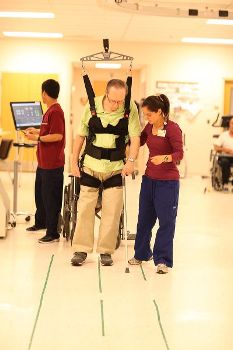Dec 15 2013
The risk and fear of falling often affects patients who are recovering from a stroke, spinal cord or brain injury, and orthopaedic injuries, and that fear may inhibit their progress in rehabilitation. The University of Maryland Rehabilitation & Orthopaedic Institute is offering a new robotic trolley system providing patients added security and allowing them to overcome that fear, thereby maximizing benefit from therapy.
 Stroke patient at Univ. of Maryland Rehabilitation & Orthopaedic Institute uses robotic body weight support system in therapy. Sourc: Univ. of Maryland Rehabilitation & Orthopaedic Institute
Stroke patient at Univ. of Maryland Rehabilitation & Orthopaedic Institute uses robotic body weight support system in therapy. Sourc: Univ. of Maryland Rehabilitation & Orthopaedic Institute
“The robotic trolley system moves on a ceiling-mounted, overhead track and connects to a harness holding the patient. The body weight support gives the patients the security to know that they will not fall, and the degree of support can be adjusted as the patients regain strength and mobility,” explains Peter Gorman, M.D., associate professor of neurology at the University of Maryland School of Medicine and chief of the division of rehabilitation at the University of Maryland Rehabilitation & Orthopaedic Institute.
The computerized device, known as the Vector Gait & Safety System, allows therapists to program the system for each patient’s needs, including individualized body weight support. The system provides real-time feedback and keeps track of each patient’s movements and distance walked, enabling therapists to analyze the data and tailor each patient’s rehabilitation program.
“The system allows many of our patients to walk earlier in their rehabilitation program without an assistive device, such as a cane or walker. Patients who have used the Vector tell us that they feel extremely secure, which gives them the confidence to progress in their rehabilitation,” says Lori Patria, director of rehabilitation therapy services at the University of Maryland Rehabilitation & Orthopaedic Institute.
“As one of nation’s leading rehabilitation and research facilities, we are committed to using innovative technologies to provide the best rehabilitative and orthopaedic care possible. We are eager to see how this robotic track system can benefit patients with a wide range of gait issues,” says Michael Jablonover, M.D., chief executive officer of the University of Maryland Rehabilitation & Orthopaedic Institute and clinical professor of medicine at the University of Maryland School of Medicine.
The 144-bed University of Maryland Rehabilitation & Orthopaedic Institute is the largest inpatient rehabilitation hospital and provider of rehabilitation services in Maryland. Patients make the transition to rehabilitation after recovering from stroke, traumatic injury, orthopaedic surgery and other illnesses.
The University of Maryland Rehabilitation & Orthopaedic Institute is part of the University of Maryland Medical System, a 12-hospital system of academic, community and specialty hospitals. For more information on the University of Maryland Rehabilitation & Orthopaedic Institute, go to www.UMRehabOrtho.org